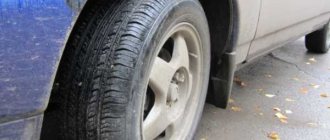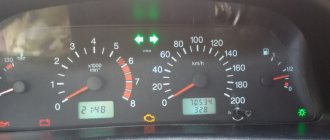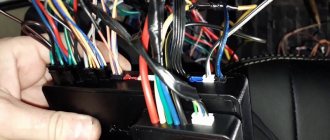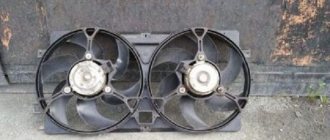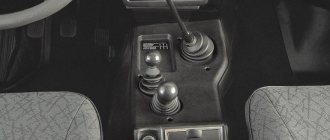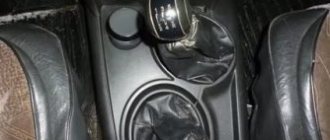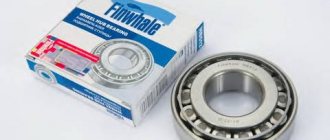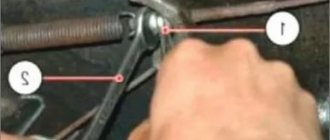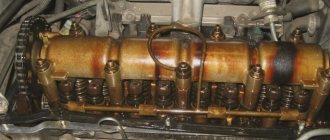- December 10, 2019
- Cars
- Vladimir Skvortsov
The favorite car of fishermen and hunters is the Niva. And the reason for this attitude is the opportunity with its help to get to remote and rarely visited places. What allows you to achieve such results? There is a lock on the Niva. How it helps and in what ways will be discussed below.
About the transmission
First of all, a few words about the structure of the Niva. It has permanent all-wheel drive. What does it mean? It's simple - torque is simultaneously transmitted to four wheels. This is one of the fundamental differences between the Niva and other cars. They supply torque to only one of the axles (front or rear).
All-wheel drive is implemented through the use of a transfer case. The torque, having passed through the gearbox, goes to the transfer case, and from it to the front and rear axles. This design makes it possible to create a locking center differential on the Niva, which, together with all-wheel drive, provides it with increased cross-country ability. Here it is necessary to say a few words about the differential. Largely thanks to him, the excellent off-road characteristics of the Niva are realized.
Chevrolet Niva
Any Niva, even a Chevrolet, has two additional transmission options in its arsenal. The driver is free to decide whether to block the center differential or not, and can choose one of two rows of the transfer case. However, the more options there are to choose from, the greater the chance of making mistakes.
TOGETHER OR AWAY?
For example, a very common recommendation is to always turn on the center lock on icy and snowy roads. Many people believe that it improves the car's behavior on slippery roads. Let's check by measuring the car's acceleration on ice and snow, the passage of an ice circle and the speed of successfully performing a changeover on compacted snow. Skidding braking was excluded, since the condition of the center differential does not affect the braking distance. At the same time, we assessed the ease of driving and maneuverability in deep snowdrifts.
The test was held by Chevrolet Niva on Nokian HKPL R velcro tires with dimensions 205/70R15. An extract from the grade book is in the tables below.
Understanding the differential
This device allows the car to move freely in a given direction. When turning, the left and right wheels of the car travel different paths. And if they are rigidly connected, then one will slip and the other will slow down. In addition, in this case, the load on the axle increases sharply, which will result in its breakdown or excessive wear of the rubber.
The differential allows you to cope with this problem. On conventional cars it is located on the axle between the wheels, allowing them to rotate independently of each other. The differential distributes the torque received by it between the wheels, and not in equal proportions, but depending on the driving conditions of each - one more, one less.
The same applies to axles in general (front and rear). Their movement, for example when turning, also differs. To distribute forces, a so-called center differential is used. Thanks to it, depending on driving conditions, the torque transmitted to the front and rear axles will differ.
Features of differential operation
The moment is distributed in such a way that it is transferred to where the load is less. This can be confirmed by the usual picture - the car has three wheels on the asphalt, and one on the ice. She fails to move. The friction force of rubber on ice is much less than that of rubber on asphalt, which means that the load on a wheel standing on ice is less than on others.
And the differential transmits all the torque towards the minimum load. As a result, one wheel rotates at breakneck speed, while the rest stand still and the car does not move. The situation is approximately the same when a car cannot climb a mountain on an icy road. In this case, one wheel caught on ice spins, but the car stops.
Work that no one needs is being done. The wheel “grinds” the road surface (ice). Getting rid of such useless work is blocking both on the Niva and on any other car adapted to difficult roads. But usually the devices described are not available on all machines.
How to use the cross-axle differential device lock
Before you start using the cross-axle differential locking mechanism, you need to find where the corresponding shift lever is located on the Chevrolet Niva. In the car interior of this SUV, between the front seats - driver and passenger, there are two levers with handles of different lengths:
- the first is for changing gears (it has a longer handle);
- the second is for controlling the transfer gearbox (it has a shorter handle).
Now let's look at the entire process of controlling the blocking process of the cross-wheel differential device.
- As soon as the vehicle enters the off-road lane, it should be stopped.
- Turn on the differential locking process using a lever with a short handle - move it to the left side (if everything is done correctly, the corresponding lamp indicator will light up on the dashboard).
- Drive off-road with the differential lock engaged.
- As soon as the vehicle drives onto a flat road, the lock should be turned off - move the lever with the short handle to the right.
- You can continue moving.
All the described actions for turning on the differential device blocking are effective when the weight is unevenly distributed between the wheels of one axle.
Disabling the differential locking process on a Chevrolet Niva is necessary when driving on a good road. Otherwise, excessive loads on the vehicle transmission will lead to increased fuel consumption and rapid wear of the tires on the wheels.
Experts pay attention to the following nuance: blocking the inter-wheel differential device will not increase the adhesion force of the wheels to the road surface.
What are the types of blocking?
Usually there are two types - inter-wheel and inter-axle. The first ones block the operation of the differential installed between the wheels on one axis. The purpose of the interaxle blocking is to ensure the distribution of forces between the axles.
The Niva has three differentials, a center differential and two cross-axle differentials. But they are fundamentally different. If the inter-axle differentials are free, there are no additional devices on them, then the inter-axle differential has a forced lock. It greatly facilitates the movement of the vehicle in off-road conditions, partially giving it the capabilities of an all-terrain vehicle.
How does the differential lock work on the Niva, the principle of operation
When driving on a normal road, torque is distributed relatively evenly between all wheels. But off-road, in the mud, this is not enough. A simple situation - the car has skidded, for example the left rear wheel. Then all the torque will go there, and the car will not be able to drive. In such a situation, no all-wheel drive will help.
But there is a way out. You need to turn on the center lock. How does such a device work on Niva? The transfer case has a special clutch. When the lock is activated, it connects the shafts that transmit torque to the axles. Let's just say that the force produced by the engine is forcibly divided equally between them. Thus, the entire moment does not go to the slipping wheel, but part of it goes to the front axle (in our example).
Now the four-wheel drive starts working. When the locking is on, the front axle is forced to receive half the torque produced by the engine. Thanks to this, the car starts to move. As soon as it starts moving, the slipping of the rear wheel will stop, and torque will flow to all the others. Then the Niva will safely overcome the difficult section.
It should be noted that the Lada 4x4 car is not the only owner of the described device. A similar differential lock works both on the Chevrolet Niva and on other SUV models, however, it can be implemented in different ways. But nevertheless it performs similar tasks.
My review of Dak and racing
It just so happened that I had to use the two mentioned types of self-blocks. Their price at the time of purchase was almost the same - ten thousand, the installation is also the same, but the result is completely different.
If the DAK failed after about six months, and not in intensive use, but when driving on ordinary forest roads, then the Togliatti one (val racing) is still working.
Maybe I was just unlucky, but I have repeatedly come across reports that there are problems with the quality of the metal in the production of DAKs. So think for yourself.
Is it necessary?
There are a huge number of opinions about whether a self-block is needed at all, and the most polar ones - from “why is it needed” to “is absolutely necessary.” As always, the choice is a personal matter and everyone must make it themselves.
Again, I will only express my opinion.
It seems to me that everything depends on how and where you move in your car. If you go to the country or mostly on asphalt, then you definitely don’t need a self-block.
The situation is approximately the same if your hobby is off-roading and you are engaged in conquering impassable roads. Here, such “half measures” as self-locking will not work and here you need a full manual differential lock.
However, if your task is to overcome not too severe off-road conditions, driving along a wet, broken forest road, i.e. normal conditions without extreme conditions, then self-block can be a good helper in such conditions.
One should also take into account the fact that when using a self-block, additional significant loads arise on the axle shafts and their breakdowns are quite frequent. Therefore, you need to either install reinforced axle shafts, or if there is a very serious obstacle, do not force the car, but arm yourself with a shovel and a jack and help it cope with the trouble.
Maybe it seems to me, maybe I have the self-locking set up this way, maybe that’s not the issue, but often when the car starts to “slip”, a jerk in the opposite direction suddenly appears. It’s as if the car first went to where the wheel was blocked, and then it gained momentum again, and the car jerks in the opposite direction.
Maybe this is not related to the self-blocking system, but I know this feature of the car’s behavior on a broken road and am always ready for it. Perhaps this will be useful to someone. In all respects the behavior of the car is absolutely normal
A self-locking differential for the Niva is a good addition that, if used correctly, can significantly improve its off-road properties.
When to use blocking
Under normal road conditions, you don’t need to turn on anything on the Niva. But on a country road or before a steep climb, the driver should think about safety nets. We have already found out how blocking works on Niva. So you should resort to its help if obstacles arise while driving, and this must be done in advance, before the car gets stuck.
If there is a difficult section ahead, it is best to turn on the blocking in advance, especially since it does not take much time. You just need to remember that using the lock unnecessarily does not contribute to the safety of the car and leads to excessive consumption of gasoline and tire wear.
How to enable blocking
It's quite easy to do. On the Lada 4x4 car there are three levers to the right of the driver, we are interested in the smallest one. When the driver moves it back, the lock on the Niva 2121 works; as soon as the driver moves the handle forward, the mode will turn off. It is best to carry out all manipulations while the vehicle is stationary.
Experienced drivers know that the lock does not always turn on (off) the first time. The fact is that the shafts may not be in the right position or they may “bite” if additional force is applied to the coupling (for example, the car has stopped while turning). Then you need to drive forward or backward a little, align the wheels and try again. As a rule, in this case everything turns on.
On the Chevrolet Niva, this procedure is performed differently. There are not two levers to control the transfer case modes, but one. The one we need is located closer to the driver. Although the locks on the Niva-Chevrolet, as well as on the Lada 4x4, work in the same way, they are activated differently. On a Chevrolet, to do this, the transfer case mode control lever must be moved with the clutch depressed while the car is stationary to the left (towards you). To disable the blocking, go in the opposite direction.
Enabling the differential lock
On the Chevrolet Niva it is possible to turn on all three differentials at the same time . Thanks to this, the vehicle’s cross-country ability increases several times when driving off-road.
Forced locking means that the drive wheels are combined with each other, as a result of which they can rotate at the same speed. Thanks to the blocking, the traction force of the engine will be used to the maximum and transmitted to the wheels.
As already mentioned, the differential assembly consists of shafts and gears. With their help, the traction force is automatically distributed between the drive wheels. The differential is locked using a blocker (clutch) . In this case, when the driver turns on the forced locking, the wheels “become” connected to each other. This helps ensure that they rotate evenly.
Differential assembly
If the center lock is forcibly engaged, then the front and rear axles are also rigidly connected at once, which guarantees an even distribution of traction to all four wheels. Thus, the vehicle’s cross-country ability will be increased several times , which makes the Chevrolet Niva a real SUV.
Applying a lock
Not all cars are equipped with blockers, and therefore they will be vulnerable off-road. In this regard, Chevrolet is a unique car that can move with either one or all-wheel drive , which allows it to feel confident even on mountain roads.
To engage the differential lock, pull the lever all the way to the left.
Forced blocking should be enabled in the following cases:
- When overcoming difficult sections of the route. In this case, the blocking should be turned on in advance, even before leaving for such an area.
- On steep climbs or slopes when wheel slip is possible.
- When driving on sand.
- When driving on snow or ice.
Disable blocking
When the Niva moves on a regular road with a smooth surface, it will not need to lock all wheels. They will adhere normally to the surface and not slip, since the traction force from the engine will be distributed evenly over them. For this reason, when the car is moving on a good road where the wheels will not slip, the use of a differential will not be required .
The differential lock on the Niva is a faithful assistant to the driver
All-wheel drive does not always provide off-road capability. Often this is not enough. When, as on the Niva, the locking works in conjunction with all-wheel drive, we can say that the car is at least close to all-terrain vehicles. And with such a car it is quite possible, if not to conquer the muddy roads, then to move quite safely along country and abandoned roads.
But do not forget that differential locking is a mode for difficult driving conditions. But there is no need to be afraid of him. We must remember that blocking allows the Niva to drive where others will not even try to do so. But you shouldn’t turn it on unnecessarily in the city. This is fraught with excessive gasoline consumption, tire wear, and ultimately, car breakdown.
Self-installation of the mechanism
As mentioned earlier, it is necessary to install a differential on a Niva yourself, taking into account the class of the road, the type of vehicle and the degree of its wear. To work you will need to drive onto an overpass. This is easy to find in a garage cooperative. Before starting work, you must make sure that the diagram with the technical description is in front of your eyes (IMAGE 1).
From the theoretical part you need to move smoothly to the practical. To work you will need a standard set of tools. Using wrenches and a screwdriver, the self-locking differential is unscrewed. After this, a visual inspection of the area is carried out. The presence of minimal chips or signs of physical wear on the front part or rear element requires preliminary technical replacement.
Once everything is ready, the surface is treated with anti-corrosion treatment. A new self-block that has passed preliminary testing is installed. After installation, you need to check how successfully partial or complete blocking is activated.
This helps when slipping and for off-road driving. Regular maintenance will ensure safe operation of the vehicle and reduce the likelihood of skidding. You can eliminate any malfunctions yourself or by contacting a service station.


